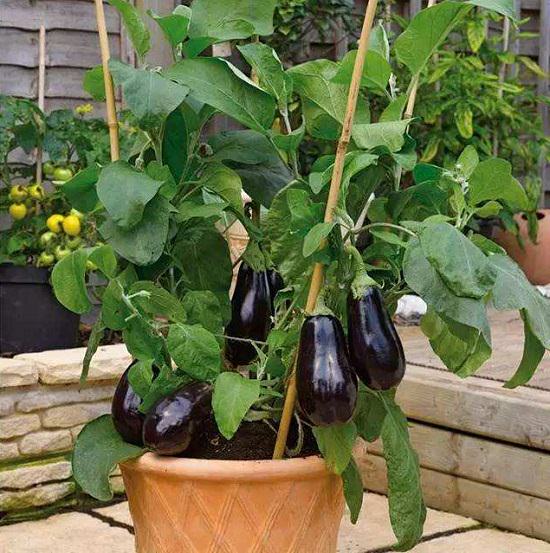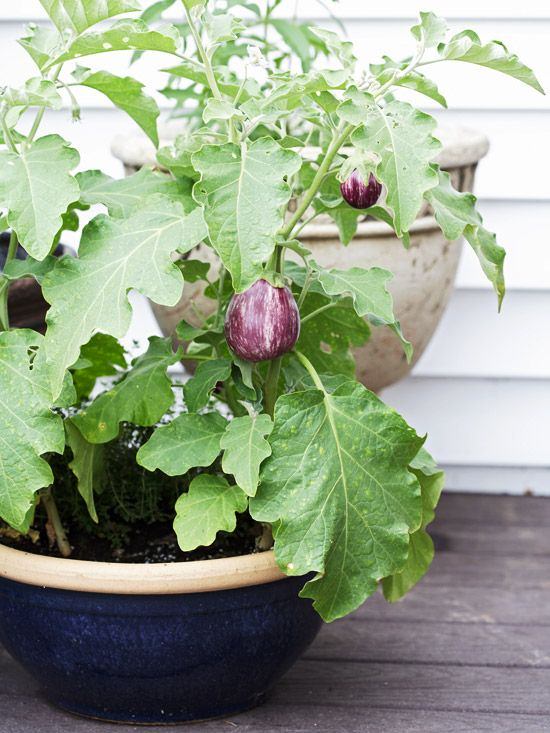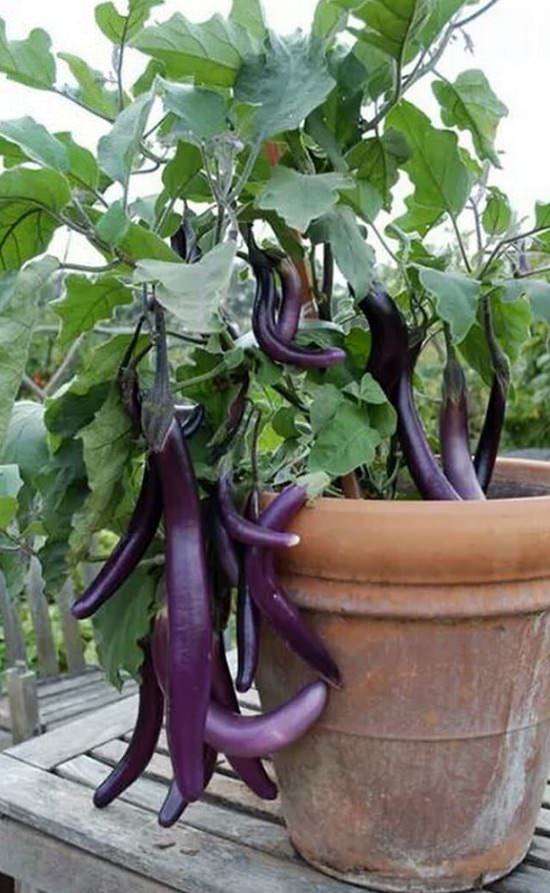Growing eggplants in containers is not complicated. Just follow this quick and easy guide for a productive eggplant garden!
Ready to start growing eggplants the easy way? Keep on reading for information on how to grow and care for eggplant in pots.
Eggplant Information
Eggplant is a perennial tropical vegetable plant native to South and East Asia (namely, China and India) and a member of the tomato family. The plant loves heat and full sun and requires evenly moist soil in its native environment to thrive and fruit heavily.
These are medium-sized bushes, and nowadays, many more dwarf and compact cultivars are available for limited-space gardeners. Similar to the other cousins of the nightshade family, e.g., tomatoes and peppers, it is very much possible to grow this vegetable in a container.
Common Names: Solanum melongena, Aubergine, Brinjal, Baingan, Vankaya, Berengena, Berinjela
Is eggplant a fruit like tomatoes? Find out here
How to Grow Eggplants in Pots

Growing eggplants in pots is possible in two ways– Either start them using seeds or buy the seedlings from a nearby nursery or garden center. If you’re new to growing plants and have not grown them much– purchase a few seedlings of your favorite eggplant variety. This will make things hassle-free! If you’ve decided to germinate them from seeds, then that is also relatively easy.
1. Planting Time
Usually, in the spring, it’s the season when eggplant seedlings are transplanted on the ground when all the dangers of frost are passed. But container-grown eggplants can be planted in summer and even in early fall if you’re ready to move the pots here and there to control the temperature, especially during the nighttime when the temperature dips down.
If you’re growing eggplants in a hot and warm frost-free climate, planting in winter is also possible.
Note: This vegetable plant is more sensitive to low temperatures than tomatoes and peppers.
2. Starting Eggplants from Seeds
Ensure you plant up to two seeds in each cell of a seedling tray or directly sow two seeds in each container. Remember, eggplants require a lot of warmth for germination, more than tomatoes and peppers.
Therefore, if you think the outdoors is not warm enough (daytime temperature around or above 65 F (18 C) is good enough for eggplant seeds to germinate), you can place them indoors to kick start their growth–that’s the best of container gardening. Once they have sprouted and had up to four real leaves, they can be transplanted into the desired containers.
12 Simple Seed Germination Tips To Grow Every Seed
3. Choosing a Pot
You’ll need a large container, depending on the cultivar; the larger the variety you’re growing, the larger the pot!
Usually, the aubergine (another name for it) plant is relatively large, similar to a pepper plant or tomato, so it requires a large pot, which should be big enough for a volume of five-gallon soil, at least.
In other words, use a pot that is at least 12 inches deep in size for each plant. If growing in a cooler region, choose a pot that retains heat.
Plant Pot Sizes Inches to Gallon
Requirements for Growing Eggplants in Containers

Sunlight
Place the pots in a spot that has good air circulation and gets direct sunlight and some wind. This is because eggplant requires a lot of warmth and sun exposure when growing. West or south-facing direction is appropriate.
Soil
Growing eggplants require a lot of nutrients for growth and a neutral or slightly acidic soil pH.
Use soil that is rich in nutrients, most preferably loamy, soilless potting mix. Eggplants thrive in soil that has adequate and sufficient moisture, so think about the moisture-retaining capability of the soil as well.
How to Make Your Own Potting Soil | Potting Mix Recipes For Everything
Therefore, you should also add a lot of compost or aged manure to the soil to enhance its capacity to retain water.
Watering
Eggplants love to grow in evenly moist soil, it’s because they grow in full sun, and windy and warm weather. Ensure you provide adequate moisture for them if you’re providing these conditions!
Make sure the drainage is good to avoid root rot. Also, take care not to saturate the soil with too much water, making it soggy when growing eggplant.
How To Water Plants + 5 Watering Mistakes You’re Doing
Temperature
Once the plants are germinated and transplanted into the pots, provide them heat and try to keep them at least at a temperature above 50-54 F (10-12 C). If you’re growing eggplants in a warm climate, you don’t need to worry about temperature requirements much.
Eggplant Care

Fertilizer
To provide ample nutrients for more productivity when growing eggplant, you should apply fertilizer following the recommendations on the fertilizer bag.
As eggplants are heavy feeders and need a fertilizer high in phosphorous, use the 5-10-5 fertilizer or other in a similar ratio; you can apply the balanced fertilizer also and that would be easier. Both the liquid and granular fertilizers work; you can also substitute them with well-rotted cow manure. Application of bone meal gives favorable results as well.
If required, spray on the leaves of your plants with liquid plant food, typically known as foliar feeding.
Dried Banana Peel Powder Fertilizer at Home for Any Plant
Pruning and Removing Suckers
Growing eggplant in a pot is not different than tomatoes. However, pruning it and picking the suckers is not necessary, but to improve productivity, you can do this. When the plants are mature, you’ll need to look out for suckers to remove them.
Yellowing or diseased leaves or branches growing tall and lanky and hindering growth and productivity should be removed, too.
Staking
As the eggplant bush grows tall and its fruits are plump and heavy, you’ll need to tie your plants to the stake to support them. The most simple thing you can do is thrust a stick into the pot and tie your plant to it.
You can also use a cage to help the plant from falling.
Pests and Diseases
The most common pest for the eggplant is the black flea beetle, which feeds on the leaves of the plant; these insects are a common sight, but if the plant is healthy, they won’t do any harm, and also the aphids.
One more typical pest is the cutworm. This worm, as its name suggests, usually cuts the plant at its base. This can be prevented by using a cutworm collar, or you can easily eliminate them by yourself. These pests can also be controlled using chemical pesticides, which we don’t recommend.
50 Types of Common Pests in Your Garden & How to Get Rid of Them
Overall, growing eggplants is easier than many other vegetables as they don’t get affected by diseases often. However, if you want, check out the list of eggplant diseases here!
Harvesting Eggplant
The eggplant usually reaches maturity after two to three months after planting, to say more clearly, in 60-80 days, depending more on the type of variety you’re growing and the climate. At around this time, the plant starts to produce big juicy fruits that grow to become super glossy and alluring when fully mature.



Amazing….now I do it the right way…thanks…
Brilliant Explanation
You have given very good information about growing brinjal in the pot, I thank you for that.
Thanks very helpful
Can there be more than one plant in a pot, or does it like to be “alone”?